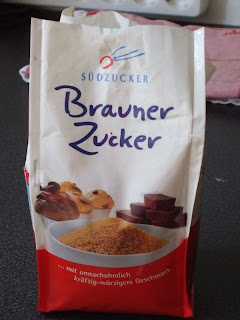For some reason, Germans do not seem to like linguine. Or at least, their supermarkets do not carry it.
I have been to several supermarkets, covering all sorts of chains, and have only found one Kaufhof that stocks linguine in only one brand. Unfortunately, today when I went there, it was out of stock. Instead, I discovered that spaghetti covered its former spot. Not much of a surprise- spaghetti is one of the most popular types of pasta here in Germany. So the next time I find some linguine, I have made a resolution to buy the entire stock of it.
Wednesday, October 28, 2009
Tuesday, October 27, 2009
Hmmm Apples
My mother in law a few weeks ago brought me some apples so I have been wondering what to do with them. Eating apples plain is not my favorite fruit by far so after consulting my cookbook, I found a delicious recipe. It basically tastes like apple pie minus the crust. Overall, very delicious, and highly recommended.
Dessert Apples
4 tablespoons butter
1.5 lbs apples-peeled, cored and cut into chunks
1/2 C sugar (either granulated or brown)
1/2 teaspoon ground cinnamon
1. Melt the butter over medium heat in a skillet with a lid. When butter is melted, add the apples and stir. Cover, turn heat to low and cook for 10 minutes.
2. Remove the lid, and add the sugar and cinnamon. Turn heat to medium. Stir frequently until the apples are hot and glazed (about 10 minutes).
Dessert Apples
4 tablespoons butter
1.5 lbs apples-peeled, cored and cut into chunks
1/2 C sugar (either granulated or brown)
1/2 teaspoon ground cinnamon
1. Melt the butter over medium heat in a skillet with a lid. When butter is melted, add the apples and stir. Cover, turn heat to low and cook for 10 minutes.
2. Remove the lid, and add the sugar and cinnamon. Turn heat to medium. Stir frequently until the apples are hot and glazed (about 10 minutes).
Tuesday, July 28, 2009
Brauner Zucker
 In Germany as in most other parts Europe, American-style brown sugar (moist, tasty and of course brown) is unavailable or at least perceived as unavailable at the average German grocery store. Of course, you can always substitute it for white sugar with molasses (1 cup white sugar to 2 tablespoons molasses). While it is more or less a usable equivalent, there are some limitations. One such example is that it is easy to put slightly too much molasses giving the baked good a strong molasses taste.
In Germany as in most other parts Europe, American-style brown sugar (moist, tasty and of course brown) is unavailable or at least perceived as unavailable at the average German grocery store. Of course, you can always substitute it for white sugar with molasses (1 cup white sugar to 2 tablespoons molasses). While it is more or less a usable equivalent, there are some limitations. One such example is that it is easy to put slightly too much molasses giving the baked good a strong molasses taste.For those of us Americans who are addicted to American-style baking, this presents a challenge. However, while browsing the local supermarket, my fiancé and I discovered "Brauner Zucker" that had the potential to be similar, if not equivalent to American brown sugar. For starters, it was not raw sugar which is the typical German brown sugar. The outside of the package had a photo of muffins and brownies. The sugar felt moist. Could this be it?
A few days later, I opened up the brown sugar to make my all-time favorite cookie recipe (see below). I was only slightly disappointed. While very close to brown sugar, the consistency is just a little too dry and the grains of sugar too large. However, I still decided to use this brown sugar in the recipe along with 1 teaspoon of molasses to make up for the lack of moisture. The results were fabulous.
If you want to try it for yourself, here is the recipe along with some useful German vocabulary:
Oatmeal Walnut Chocolate Chunk Cookies
1/2 C whole wheat flour (Weizen-Vollkorn-Mehl)
3/4 tsp cinnamon
1/4 tsp nutmeg
1/2 tsp baking soda, American
1/2 tsp salt
2 C rolled oats (Haferflocken)
3/4 C chopped walnuts
1/2 C butter, softened
1/2 C brauner zucker
1 tsp molasses
1/4 C granulated sugar
1 egg
3 T water
2 tsp vanilla
1 bar bittersweet chocolate (60-70% cocoa), chopped (Zartbitter)
1. Preheat oven to 175 C.
2. Grease baking sheet or cover with backpapier.
3. In a small bowl, combine dry ingredients (flour, cinnamon, nutmeg, baking soda, salt, oats and walnuts).
4. In a large bowl, cream butter. Add sugar and beat. Then, beat in egg, water, and vanilla.
5. Stir dry ingredients into wet ones.
6. Add chocolate chunks.
7. Bake 12 to 15 minutes or until the cookies are brown on the bottom. Do not let cookies brown on top. When chocolate is melted, they should be close.
8. Cool and eat.
Subscribe to:
Comments (Atom)
